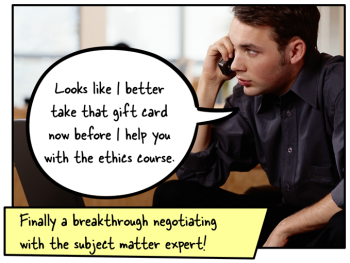
A large part of your success hinges on the relationship you have with the course’s subject matter experts. They play a critical role by providing guidance, expertise, and context for much of your course’s content. However, the subject matter experts can also be a source of frustration. Many times they won’t budge when it comes to getting rid of extra information. Or they have their own ideas on how the course should be designed which conflicts with yours.
In today’s post we’ll review some challenges when working subject matter experts and how to overcome them.
Five Challenges Working with a Subject Matter Expert
Here are some common challenges when working with your subject matter expert.
- They know everything. Their expertise comes from years of experience. Often they lose sight of this when trying to teach new people. Because of this, they tend to over emphasize the value of some content or think everything is equally important.
- They’ve invested time in existing content. Much of the material you get comes from existing classroom content. And often this content has been created by the subject matter experts. That means they’ve already invested time in building the course just the right way. They’ve also spent time selecting color schemes, fonts, and clip art.
- Their expectations are based on experience. One reason there are so many linear, click-and-read courses is because that’s what people think elearning should be. It’s what they’ve experienced so it must be right. Plus, a linear course is a systematic way to ensure that all of the important information is presented.
- They don’t want the fancy schmancy bells and whistles. Interactive content seems like extra work with a bunch of bells and whistles. Why do you need more than a few slides of information and a multiple choice quiz? Seems like a waste of money to build interactive scenarios. Also, who has time to create all of those branches? It’s hard enough to come up with ten good quiz questions.
- They’re not part of the project team. I’ve worked on plenty of projects where I need to do research and the client directs me to a subject matter expert. Often the experts don’t know anything about the project and they can get a bit territorial when a non-expert steps onto their turf. Because of this, they aren’t always committed to the success of the course. To them, you’re an intrusion on their productivity and possibly even a threat to what they do.
Five Ways to Work with Subject Matter Experts
While it can be challenging working with subject matter experts, they do a place an important role in the construction of your online training program. Because of this, you need to mitigate some of these challenges.
- Bring in multiple perspectives. Subject matter experts are the experts of the content. But they’re not necessarily the experts when it comes to teaching the content. Their perspective is just one part of the equation. To get a different perspective recruit recent learners of the content. Have them go through your objectives and provide some insight on what worked and what didn’t as they were learning.
- Step away from your pre-existing content. Don’t allow the existing content to dictate what you need in your course and how it needs to be designed. It’s just a resource as you research the right content for your course. One challenge is when the existing content is in PowerPoint and you use a PowerPoint-based authoring tool like Articulate Presenter to create the elearning. Once the expert knows you’re using PowerPoint, he tends to become less flexible. That’s why I like to start with a blank screen in a starter template. It forces the project to be started from scratch. I also prefer not to tell the experts that I am working with PowerPoint. That diffuses many of those issues.
- Show examples of good elearning. We’ve all had to take the standard linear elearning, where all we’re required to do is click the next button. If you build elearning courses, you’ve probably seen enough diverse examples to know that there’s more to interactive elearning than the next button. But most subject matter experts only know what they know or have experienced. So if you want them to build a different type of course be prepared to show examples of good courses that are similar to what you’d like to build. Once they see it, they get it. Also, the biggest question will be how to ensure that the learners see all of the content (which drives a lot of linear elearning). Be prepared to answer that question.
- Pay now or pay later. It’s true that a lot of interactive content is novel and may be classified as bells and whistles. But the reality is that you’re making an investment when you build an elearning course. And the organization wants to make sure that the investment pays off. If not, it’s a waste of time and money and requires making an additional investment down the road. So why not do it right the first time? Going with the tip above, show them good examples of effective interactive elearning. Also, instead of starting with a linear, sequential design (which is standard) use a backwards design where you start from the final assessment and work backwards. This way the course is focused on assessing the desired behaviors rather than the novelty of interactions.
- Honor the subject matter experts’ contributions. Just like you and everyone else, the subject matter expert is pressed for time. So having to spend time on a project they’re not part of is low on their priority list. The easiest thing is to get them on the project and have the client make your project a priority. But if that’s not possible, then find ways to honor their contributions. Send emails that rave about what they’ve done and CC their managers. This is good to do right before their annual review. Give them an occasional gift card from Starbucks or Amazon. Be committed to do anything to build good will and positive regard. Also, don’t waste their time. Set clear expectations and make sure to follow through.
Subject matter experts play a key role when developing your course content. Because of this you’ll want to develop a good working relationship that is respectful. Often I find that our industry complains a lot about the subject matter experts. They’re not our adversaries. They’re partners in the organization’s success. By following some of the tips above you’ll build a good relationship and shape the perspective to build effective and meaningful online courses.
What challenges do you face when working with subject matter experts and how have you resolved them? Share your tips here.
Events
Free E-Learning Resources















0
comments